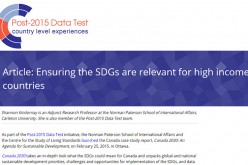Including girls in the post-2015 agenda: The role of sub-national governments
This post has been written by Khalida Ghaus, Director of the Social Policy and Development Centre (SPDC) in Pakistan who has just published her paper – Intergovernmental Fiscal Transfers and Gender Sensitive Education Financing – as part of the Southern Voice Initiative.
Reducing the gap between girls and boys in education is one goal that should persist in the next development agenda. But how can governments accomplish this goal? Beyond all the educational policy one must also look closely at how resources are allocated to education. In many developing countries this is not a straight forward question, with decentralization processes having become popular, the responsibility for providing education varies: in some countries the central government has a major role, and in others the provincial or state governments have been given the responsibility to provide these services. So how should the next development agenda include subnational governments?
The Pakistani Case
In our recent research paper, we have focused on the case of Pakistan. Its performance in the education sector has been very weak and the government at all levels has not been successful in achieving gender parity in primary and secondary education.For example, against the MDG target of 100 percent net enrolment in primary education (5-9 years of age) by 2015 only 56 percent could be achieved by 2010-11. Similarly, the gender parity index (0.88 in 2010-11) shows that fewer girls than boys of primary age attend school.
There are several reasons for this slow progress towards MDG 2 and 3. The budget allocated to education is low; is less gender sensitive; and is largely spent on administrative items like salaries. Moreover, this low public spending on education was biased against females. One of the major reasons for a dismally low share of public spending allocated to education in Pakistan is a lack of available resources at provincial levels. Taxes such as income, sales tax on goods and customs and excise duties are vested in the federal domain; while residual taxes like agriculture income tax, sales tax on services, motor vehicle tax and others are in the provincial domain.
This leaves little scope for provincial resource mobilisation besides increasing dependency on federal transfers to finance their expenditures. These intergovernmental fiscal transfers are constituted through National Finance Commission (NFC) awards and are said to be the financial lifeline of the provincial governments. The low shares of intergovernmental transfers allocated to provinces are thus the basis of low funding to education, which obstructs and has prevented achieving the goal of universal primary education.
Despite slow progress towards the MDG targets related to education, higher federal transfers to provinces did not translate into higher spending on education in these provinces. This apparent disconnect between the federal transfers to provinces and provincial spending can largely be attributed to the absence of a gendered approach, particularly in the distribution of resources among provinces. This means that the scheme to transfer resources to the provinces did not take into consideration the fiscal needs of education for the two sexes. In other words, financial resources transferred to provinces were not linked with the MDG costing exercise conducted earlier to bring in children that were out of school.
In my paper exploring this dynamic I apply an empirical model based on a micro-theoretic foundation to estimate the impact of intergovernmental transfers, grants and borrowing on education financing. The results presented in this paper show that increasing the amount of resources to provincial governments through intergovernmental fiscal transfers and grants constituted through NFC awards leads only to a marginal increase in provincial expenditure on education. This marginal increase is less than the desired level of education spending needed to achieve MDGs 2 and 3. One striking finding is the greater positive impact of provincial borrowing and gender sensitive interventions on education expenditures. This leads to two policy choices:
(1) That provincial governments are directed to design and implement gender sensitive projects in the education sector without making it conditional on NFC awards;
(2) That gender-sensitive interventions are integrated into the design of NFC awards and then properly monitored through the NFC. These suggestions would help to link intergovernmental transfers with education outcomes, besides encouraging gender-sensitive changes in the future design of NFC awards.
Moreover, it would facilitate an increase in the level of resources allocated to education as a percentage of GDP, which, in turn would also help to achieve gender equality in the sector.
Implications for the post 2015 debate
MDGs were tackled by several governments as planning goals rather than as development goals. The interpretation and planning remain faulty and oblivious to the political structure and governance existing in a country. Yet these are both crucial in fulfilling a country’s national and international commitments to development.
In federal systems of government, sub-national (provincial or state) governments are important stakeholders and key players in achieving the development targets, since they are responsible for delivering and financing most social services. Exclusive focus on central government, ignoring the role and diversity of sub-national governments, may lead to more future failures to achieve development goals and targets, as has happened in the case of Pakistan in relation to girls’ education.
To ensure a proactive role for sub-national governments in the post 2015 framework the following measures are necessary:
1. Encourage and ensure greater focus on gender sensitive interventions at sub-national level rather than at federal level.
2. Require that financial resources be allocated to the sub-national level with greater output based accountability and a transparent monitoring mechanism.
3. Design intergovernmental fiscal transfers based on gender sensitive indicators related to post-MDG commitments, along with an incentive mechanism specifically for those provinces or states in which MDG progress has lagged furthest behind.
1,180 total views, 1 views today









